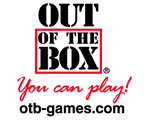 By Matt Nuccio
By Matt NuccioThe origin of Faux●Cabulary goes back to a party that my wife (then girlfriend) and I had back in 2006. Unfortunately, I don't recall the party or what sparked the inspiration—I guess it was a rough night—I just remember waking up with a name that I wanted to build a game around. That name was not Faux●Cabulary (which would come later) but, "What the Bluff?" I had what I thought was a funny name and I wanted to create a solid party game around it.
The first version of What the Bluff? was a card game. The game included ‘fake word’ cards and players bluffed their made-up definitions for these words. I spent a year showing it around the industry to great reaction, just no takers. I received a laundry list of reasons why people weren’t interested-- too many card games on the market, word games don't make good party games, the name was possibly offensive. So, I moved onto the next project and then the next. I had forgotten about the game all together.
Then, sometime around 2009, two things happened that brought What the Bluff? back to life. The first was I met Al Waller, the owner of Out of the Box Publishing. The second was the creation of another game I did called "A Bee C Match Game" (Endless Games). When I meet Al, I immediately took to him and his team. I knew they had a keen sense of how to sell a party game—just look at their track record! I wanted to publish a game with Out of the Box. I went back to the studio and dug up a few concepts including What the Bluff? I play tested all of my old concepts again and found that What the Bluff? did not stand out the way I remembered it. I found the card game aspect to be too traditional-- yawn! I wanted to create something that didn't just play well, but felt different in your hands, too. This is where A Bee C Match Game came in. I had spent the previous year building a children's spelling game with letter dice. My testing showed that people loved the dice aspect. So, I ditched the cards and added dice for creating the fake words. I tested the game all over the country-- with friends, family, friends of family . . . whoever would play it!
I presented the game to Al in October of 2009 at the Dallas Toy Preview. He immediately liked the game, but we felt it needed some polishing. Al took a copy of the game back to Out of the Box and played it with his team. With feedback from Out of the Box and my play test groups, I simplified the game by prewriting all the definitions and reversed the rules so that one person read the definitions and the other players came up with the fake words.
We reconvened that February at the New York Toy Fair. This time, my cousin Chris and I met with the entire Out of the Box team for a few rounds of the new and improved What the Bluff?-- The game was a smash hit. A few weeks later we had a deal in place.
Over the next few months my team and Out of the Box continually tested and fine-tuned the content. Some of the content was toned down (the original was a bit racier) and some of the dud word-parts and definitions were rewritten or replaced with better ones. The hardest part was the name. I always loved What the Bluff?, but the game had changed so much since its inception that it was no longer relevant. My team and I spent months going back and forth with Out of the Box with new name suggestions. There were hundreds of names thrown around; ultimately we all decided on Faux●Cabulary. It fit the game perfectly—Faux (pronounced Fo) from the French, meaning fake, and Cabulary from the word vocabulary. From there, my team and I did the artwork for the box and cards.

No comments:
Post a Comment